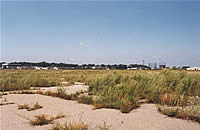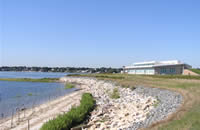Waste Site Cleanup & Reuse in New England
Save the Bay Center - Providence, RI
(June 2006)
Programs: EPA
Assessment Grant, Revolving
Loan Fund Grant & EPA
Targeted Brownfield Assessment
Grant Recipients: Rhode
Island Department of Environmental Management (RIDEM), Rhode
Island Economic Development Corporation (RIEDC) & City of Providence
Summary: A former waterfront landfill and
municipal dump site at Sunshine Island, located at Fields Point on
the Providence River, has been completely transformed into the “Save
The Bay Center”, now one of the most popular spots on the Upper
Narragansett Bay.
Partners
Save the Bay, Inc. is a non-profit environmental advocacy and educational organization that protects, preserves and improves Rhode Island's Narragansett Bay.
The Rhode Island Economic Development Corporation (RIEDC) is the full service, official economic development organization for the state of Rhode Island, and is a partner in the state's business growth and revitalization.
The City of Providence (2000 population 173,000) is Rhode Island's capital and its largest city.
The State of Rhode Island (2000 population 1,048,000) and its Department of Environmental Management (RIDEM) has historically focused its brownfields efforts on two major areas: the remnants of its industrial heritage; and the urban core of its cities. Rhode Island contains eight cities and 11 Enterprise Zones, with some zones reaching poverty levels of 50% or more. The remediation and return of brownfields to productive use has contributed to economic revitalization through job creation and increased tax base; has eliminated potential environmental and health risks; and has reclaimed for public enjoyment the few natural resources left in these urban communities.
The Site
The Sunshine Island site was once a true island, and it provided access to the bay for the people of South Providence. In the 1950s the site was used as a municipal dump. Later, it was paved over to be a drive-in theater. It is part of a 60-acre parcel owned by Johnson & Wales University, for which Save the Bay holds a 50-year lease at the rate of one dollar per year.
Assessment
The TBA assessment grant for the Field's Point / Sunshine Island site was awarded in 2000, and site work took place in 2001. The primary contaminant of concern discovered was methane, a product of historical landfill operations at the site. Also found was disposed-of ash, construction and demolition debris, and elevated levels of total petroleum hydrocarbons, semivolatile organic compounds, pesticides, and metals. The TBA program also assisted Save the Bay in writing their Remedial Action Work Plan and Engineering Evaluation/Cost Analysis for the BCRLF Program.
Clean-up
The Save the Bay organization signed an agreement to borrow $700,000 from RIEDC's Brownfields Cleanup Revolving Loan Fund (BCRLF) program to clean up the brownfields site. The eventual purpose was redevelopment of the site as a state-of-the-art educational center. Known as the “Explore the Bay Initiative”, it meant to clean and redevelop the Sunshine Island brownfields site, with an eye towards expanding the educational opportunities for the public—particularly children from the state's urban core—to experience, understand and protect Narragansett Bay. The loan to Save the Bay provided $700,000, with a 30% discount, to remediate the Field's Point site for redevelopment into an ecological education center. That remediation included construction of a stone revetment, a venting system for methane release beneath the building foundation, and an engineered cap. The loan was closed in 2003.
Redevelopment
The culmination of the “Explore the Bay Initiative” was the construction of a community and family-based educational center, the “Save the Bay Center”. The main feature of the six-acre site is the education center, which consists of a 17,600-square-foot, environmentally-responsible “green” building that houses educational classrooms, exhibition space, and the new headquarters for the Save the Bay organization. Also featured are a dock and shore-side facilities to support Save the Bay's boat fleet, including the 45-foot dedicated education vessel, the “M/V Alletta Morris”; picnic areas; parking/transportation infrastructure; and habitat restoration demonstration projects. Interpretive walking trails run along a portion of the shoreline, and a walking path takes visitors through the salt marsh. For the engineering-minded, there is a demonstration stormwater runoff management system. But the common draw is the very-present waters of the Narragansett Bay.
Current Use
The project fulfilled all of its original intentions, which were to:
-
Restore access to upper Narragansett Bay at an urban site;
-
Serve urban residents who have historically been disconnected from the Bay;
-
Be a model of brownfields reclamation and reuse, including habitat restoration and shoreline development; and
-
Demonstrate environmentally responsible design and construction.
The project has accomplished all this, with significant benefits to the citizens of Rhode Island. The education center and its programs are an invaluable resource. As Save the Bay's new headquarters, the center houses the organization's staff of 34 and brings new life to the waterfront area that has been void of activity for many years. The project also created public access to Narragansett Bay for nearby residents as well as for the greater Rhode Island community.
In point of fact, it didn't take long for the center to become one of the most popular spots on the Upper Narragansett Bay. With its natural panoramic setting surrounded by the sea, and its being open to the public from dawn to dusk, it has drawn more participation than predicted. Hundreds of school children routinely visit the classrooms each year. Local fishing enthusiasts find it a popular point of access. Even tourists have discovered it as a destination. And very telling is the fact that the center has already hosted some 50 public and private events – not just the expected conferences, retreats, and community meetings, but also a bridal shower, a baby shower, a bar mitzvah, birthday party, anniversary party, and a memorial service. The folks at Save the Bay predict it won't be long before wedding ceremonies take place at the new Fields Point.
Timeline:
-
Mar 2000: The Explore The Bay Educational Center Capital Campaign was launched.
-
2001: Assessment work at the site.
-
Nov 2002: Groundbreaking.
-
2003: Construction began.
-
May 2005: Save the Bay moves its staff and operations into the new center at Field's Point.
-
Jun 2005: Public ribbon-cutting ceremony.
-
Nov 2005: The project gains even more public recognition as the winner of the 2005 Phoenix Award for New England.
- Feb 2006: Public unveiling of the 30x10 foot mural, “Our Living Bay”



